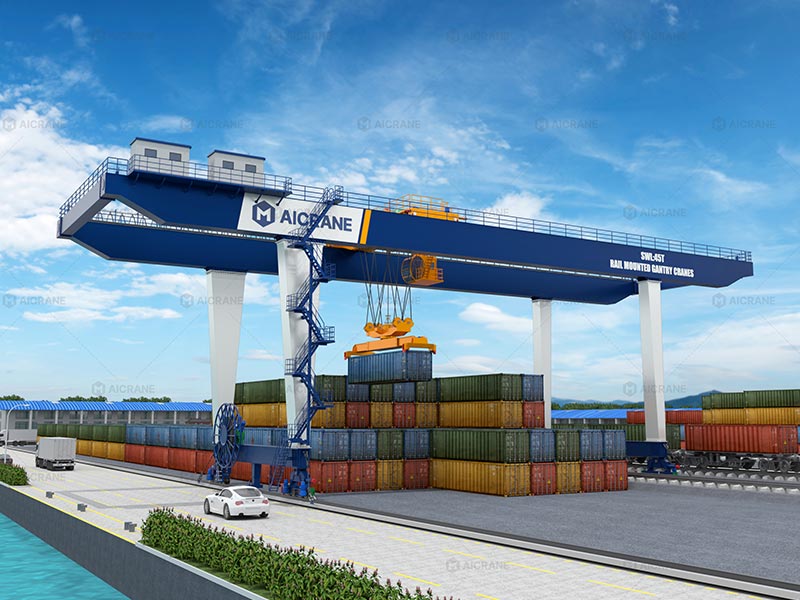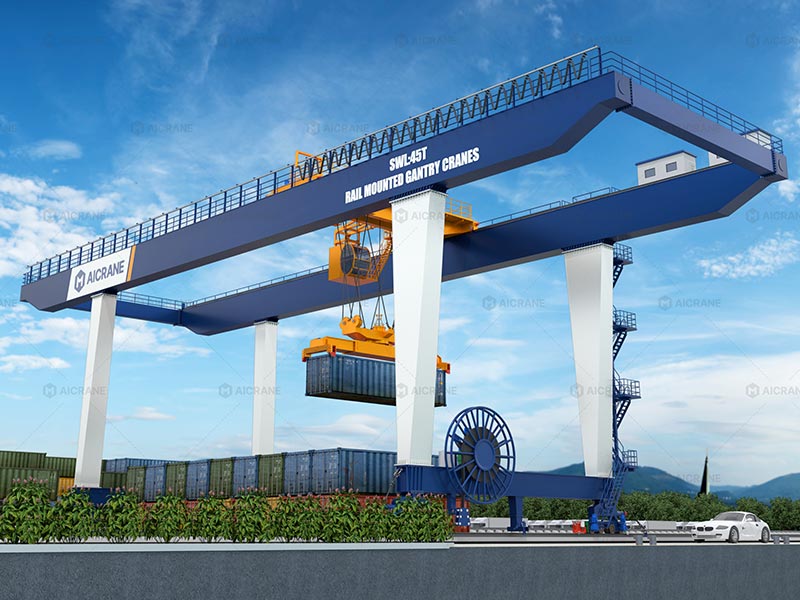Shipping container gantry cranes play an indispensable role in the global logistics chain. Whether installed at ports, intermodal terminals, or container yards, these massive cranes handle thousands of containers daily with precision and efficiency. Behind their seemingly simple motion lies a complex and well-engineered lifting mechanism designed to ensure safe, fast, and reliable handling of heavy containers. Understanding this mechanism helps operators, engineers, and port planners optimize crane performance, reduce downtime, and improve safety.

Overview of a Shipping Container Gantry Crane
A shipping container gantry crane is a type of heavy-duty lifting equipment designed for loading, unloading, and stacking shipping containers. These cranes typically come in two main types:
-
Rail Mounted Gantry (RMG) cranes – move on fixed rails and are commonly used in intermodal terminals or container yards.
-
Rubber Tyred Gantry (RTG) cranes – equipped with rubber tires that allow mobility across different working areas in a container yard.
Both types share similar lifting systems, though their power supply, mobility, and control mechanisms differ. The lifting mechanism is the core of the entire crane structure, responsible for handling the container’s weight with accuracy and balance.
Key Components of the Lifting Mechanism
The lifting mechanism of a container gantry crane is a sophisticated system that integrates mechanical, electrical, and control components.
Hoisting Motor and Gearbox
At the heart of the lifting mechanism lies the hoisting motor, typically an electric motor that provides the power required to lift and lower heavy loads. The motor’s rotation is transmitted through a gearbox that reduces speed while increasing torque, allowing smooth and controlled lifting operations.
Modern RMG and RTG cranes often use variable frequency drives (VFDs) or inverters to regulate motor speed, enabling soft starts, smooth braking, and precise control over lifting speed.
Drum and Wire Rope System
The hoisting drum is a large cylindrical component around which the wire rope is wound. The drum rotates under the power of the hoisting motor, winding or unwinding the wire rope to raise or lower the container.
The wire rope is specially designed to withstand high tensile loads, fatigue, and bending stress. It passes over a series of sheaves (pulleys) mounted on the crane’s trolley and spreader, which help distribute the load and reduce rope wear.
Spreader and Twistlocks
The spreader is the device that directly grips and lifts the container. It is attached to the end of the hoisting ropes or chains and is equipped with twistlocks at each corner. These twistlocks engage with the corner castings of the container, locking automatically when the operator lowers the spreader onto the container and activates the lock command.
Spreader types vary according to operation requirements:
-
Fixed spreaders – suitable for containers of a specific length.
-
Telescopic spreaders – can adjust their length to handle 20ft, 40ft, or 45ft containers.
-
Twin-lift spreaders – can lift two 20ft containers simultaneously for higher efficiency.
Trolley System
The trolley carries the spreader and moves horizontally along the crane girder. It contains the hoisting drum, wire ropes, sheaves, and motors. As the trolley moves along the bridge girder, it positions the container precisely over the ship, truck, or storage yard.
In modern automated ports, trolley movement and positioning are guided by laser sensors, GPS, or machine vision systems for high accuracy and repeatability.

How the Lifting Process Works
The lifting operation involves a sequence of coordinated mechanical and electrical actions controlled by the port gantry crane operator or automation system:
-
Positioning the Spreader – The operator or control system moves the trolley and spreader above the target container.
-
Engaging the Container – The spreader is lowered until it lands on the container’s top. The twistlocks automatically engage with the container’s corner castings.
-
Lifting the Load – Once locked, the hoisting motor begins to rotate, pulling the wire ropes onto the drum.
-
Traveling with the Load – While the load is suspended, the trolley moves horizontally along the crane bridge.
-
Lowering and Releasing – The hoisting mechanism unwinds the wire rope to lower the container to its destination.
Throughout this process, load sensors, limit switches, and anti-sway control systems ensure that operations are safe and precise.
Control and Safety Features in the Lifting System
To ensure reliability and safety, container gantry crane lifting mechanisms are equipped with a range of advanced control and protection systems:
Overload Protection
A load cell or load pin measures the weight being lifted. If the load exceeds the rated capacity, the system automatically halts hoisting.
Anti-Sway System
When lifting or moving containers, sway caused by inertia or wind can endanger operations. Modern cranes use anti-sway technology – based on sensors and control algorithms—to minimize swinging.
Limit Switches
These devices prevent over-travel of the hoist, ensuring the spreader does not exceed its maximum upper or lower limits.
Emergency Braking and Safety Locks
High-performance braking systems automatically engage when power is cut off or in emergencies, preventing uncontrolled descent of the load.
Real-Time Monitoring and Diagnostics
Modern RMG RTG cranes feature digital control systems with real-time feedback on motor torque, wire rope tension, and load position.
Maintenance and Inspection of the Lifting Mechanism
The reliability of a container gantry crane largely depends on routine inspection and maintenance of its lifting mechanism. Key areas to monitor include:
-
Wire ropes – inspect for wear, corrosion, or broken strands.
-
Drum and sheaves – check alignment and surface condition.
-
Spreader and twistlocks – ensure they operate smoothly and lock securely.
-
Motors and brakes – test response times, temperature, and lubrication.
-
Control systems – verify sensor calibration and communication.
Scheduled maintenance extends service life and minimizes downtime.
Technological Advancements in Lifting Mechanisms
As ports evolve into smart logistics hubs, container gantry crane lifting systems are advancing rapidly:
-
Electric hoisting systems replace hydraulic types for greater energy efficiency.
-
Regenerative braking feeds energy back into the grid.
-
Condition monitoring sensors are integrated into the wire rope and drum assembly.
-
AI-driven control algorithms optimize lifting speed and minimize sway.
-
Fully automated spreaders can lock containers without operator input.
Conclusion
The lifting mechanism of a shipping container gantry crane is a marvel of engineering that combines strength, precision, and intelligence. From the hoisting motor and wire rope system to the spreader and control technology, each component plays a vital role in ensuring efficient container handling.
By understanding how the lifting mechanism works and maintaining it properly, terminal operators can maximize uptime, enhance safety, and improve overall port efficiency. As global trade expands, innovations in crane lifting mechanisms will continue shaping the future of container logistics – smarter, faster, and more sustainable than ever before.
